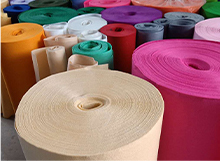types of felt
Understanding the Types of Felt A Comprehensive Guide
Felt is a versatile material that has captivated artisans, designers, and manufacturers for centuries. Made from natural or synthetic fibers, it is created through a process called felting, where heat, moisture, and friction cause the fibers to mat together and create a dense, durable fabric. The unique characteristics of felt make it an ideal choice for a multitude of applications. In this article, we will explore the various types of felt, highlighting their properties, uses, and advantages.
1. Wool Felt
Wool felt is perhaps the most well-known type of felt, prized for its softness, warmth, and durability. This type of felt is made from 100% wool fibers, which lend it a natural elasticity and resilience. Wool felt is available in a wide array of colors and thicknesses, making it a popular choice for crafting projects, clothing, and home decor.
Uses Wool felt is often used in art and craft projects, such as needle felting, appliqué, and sewing. Its warmth makes it an excellent material for hats, mittens, and blankets. It’s also used in interior design for items like wall hangings and decorative cushions.
Advantages The natural properties of wool felt make it breathable, moisture-wicking, and eco-friendly. It is also naturally flame-resistant and has a luxurious feel that enhances any project.
2. Synthetic Felt
Synthetic felt is created from man-made fibers, such as polyester and acrylic. This type of felt is known for its affordability and versatility, making it popular among crafters and manufacturers alike. Synthetic felt is typically more resistant to wear and tear compared to wool felt, but it may lack some of the natural qualities that wool offers.
Uses Synthetic felt is widely used in industrial applications, such as insulation, padding, and soundproofing. In addition, it is a favorite in educational settings for projects and activities.
Advantages One major advantage of synthetic felt is its resistance to mildew and rot, making it suitable for outdoor use. It is also available in a vast range of colors and thicknesses, giving designers ample options for their projects.
3
. Blended FeltBlended felt combines natural and synthetic fibers, creating a fabric that utilizes the best qualities of both types. Typically made from a mix of wool and polyester or acrylic, blended felt takes advantage of wool’s softness and durability while benefiting from the cost-effectiveness and durability of synthetic fibers.
types of felt

Uses This type of felt is ideal for various crafting applications, school projects, and even home furnishings. The blend allows for greater stability and colorfastness, making it a smart choice for items that may see frequent use.
Advantages Blended felt tends to be more affordable than pure wool felt while still providing a pleasant texture and a variety of colors. Its durability makes it suitable for items that require strength and resilience.
4. Craft Felt
Craft felt is a lightweight, affordable option typically made from synthetic fibers. It is popular among hobbyists and is often sold in sheets or pre-cut shapes. While not as durable as wool or blended felt, craft felt is versatile and easy to work with.
Uses Craft felt is commonly used in children’s projects, scrapbooking, home decor, and costume-making. Its ease of cutting and handling makes it a favorite among DIY enthusiasts.
Advantages One of the standout features of craft felt is its affordability. It’s readily available in many colors, which allows for creative freedom. Additionally, craft felt is non-fraying, meaning it does not require hemmed edges, simplifying the construction process.
5. Industrial Felt
Industrial felt is a heavy-duty type of felt made from wool or synthetic fibers and is designed for industrial applications. This type of felt is crafted for durability, strength, and resistance to heat and chemicals, making it suitable for various professional environments.
Uses Industrial felt is commonly used in manufacturing processes, automotive applications, and as insulation in electronic devices. It can also be found in soundproofing materials and filters.
Advantages The strength and resilience of industrial felt make it an essential material in many industries. Its ability to withstand harsh conditions ensures longevity and reliability in demanding environments.
Conclusion
Felt is a diverse and indispensable material, with each type catering to different needs and applications. From the luxurious qualities of wool felt to the affordability of craft felt, there is a type of felt suited for every purpose. Understanding the various types of felt can help artisans and crafters choose the right material for their projects, unlocking the full potential of this remarkable fabric. Whether you're crafting a cozy winter hat or undertaking an industrial project, felt remains a timeless choice that continues to inspire creativity across many fields.
-
What Makes Felt a Great Choice?NewsNov.19,2024
-
Total Mixed Ration (TMR) Feed for CattleNewsNov.19,2024
-
The Ultimate Guide for Felt Polishing WheelsNewsNov.19,2024
-
Industrial Felt for Various ApplicationsNewsNov.19,2024
-
Felt Makeup Bags and Inserts BagsNewsNov.19,2024
-
Choosing the Right Hotel TowelsNewsNov.19,2024
-
Your Go-To Guide For Affordable Wholesale Wool FeltsNewsOct.31,2024







